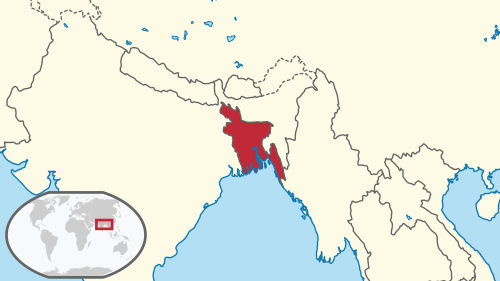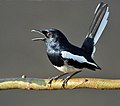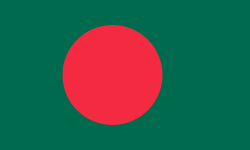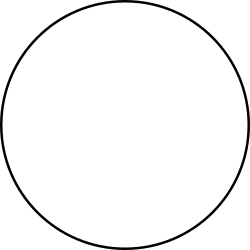Bangladesh
Bangladesh, officially called the People's Republic of Bangladesh, is a country in South Asia. It is the eighth most populated country in the world and one of the most tightly packed, with more than 170 million people living in an area of 148,460 square kilometres (57,320 sq mi). Bangladesh has land borders with India on the north, west, and east, and Myanmar on the southeast. In the south, it has a coastline along the Bay of Bengal.
People's Republic of Bangladesh | |
|---|---|
| Motto: | |
| Anthem: | |
 | |
| Capital and largest city | Dhaka 23°42′N 90°21′E / 23.700°N 90.350°E |
| Official languages | Bengali |
| Common languages | Bengali (state language), English |
| Ethnic groups (1998) | 98% Bengali 2% other[1] |
| Religion | Islam |
| Demonym(s) | Bangladeshi |
| Government | Unitary parliamentary republic[2] |
| Mohammed Shahabuddin[3] | |
| Muhammad Yunus | |
• Speaker | Vacant |
| Syed Mahmud Hossain | |
| Legislature | Jatiya Sangsad |
| Independence from Pakistan | |
• Declared | 26 March 1971 |
• Current constitution | 4 November 1972[1] |
| Area | |
• Total | 148,460 km2 (57,320 sq mi) (93th) |
• Water (%) | 6.4 |
| Population | |
• 2018 estimate | 166,368,149a (8th) |
• Density | 964.42/km2 (2,497.8/sq mi) (9th a) |
| GDP (PPP) | 2018 estimate |
• Total | $758 billion (29th)[4] |
• Per capita | $4,600[4] |
| GDP (nominal) | 2018 estimate |
• Total | $284.2 billion[4] |
• Per capita | $1,740[4] |
| Gini (2005) | 33.2[5] medium |
| HDI (2018) | medium · 136th |
| Currency | Taka (BDT) |
| Time zone | UTC+6 (BST) |
| Driving side | left |
| Calling code | +880 |
| ISO 3166 code | BD |
| Internet TLD | .bd |
Website Official website | |
| |
In the north, the Siliguri Corridor separates it from Bhutan and Nepal, and the Indian state of Sikkim separates it from China. Dhaka is the capital and the biggest city. It is also the center of politics, money, and culture. Chittagong is the second biggest city and the busiest port. Bengali is the official language. Islam is the official and biggest religion.
Bangladesh is part of the old region of Bengal, which was split during the Partition of British India in 1947. It became the eastern part of Pakistan. Long ago, Bengal was called Gangaridai and had powerful kingdoms before Islam. After 1204, Muslim rulers took control, and Bengal became important under the Bengal Sultanate and the Mughal Empire. Bengal was rich and important in trade and politics. The Battle of Plassey in 1757 started British rule, which lasted for 200 years. In 1905, Eastern Bengal and Assam were created, which later led to the making of Bangladesh. The All-India Muslim League was formed in Dhaka in 1906. In 1940, A. K. Fazlul Huq, the first Prime Minister of Bengal, suggested a separate Bengali Muslim land in the Lahore Resolution. The current border was set by the Radcliffe Line.
In 1947, East Bengal became the most crowded part of Pakistan and was renamed East Pakistan. Dhaka became its capital. The Bengali Language Movement in 1952, a military takeover in 1958, and the 1970 general election led to strong Bengali nationalism and demands for democracy. The Pakistan military refused to give power to the Awami League, led by Sheikh Mujibur Rahman. This started the Bangladesh Liberation War in 1971. The Mukti Bahini fought and won, and the war included the genocide of Bangladeshis. On 16 December 1971, Pakistan surrendered, and Bangladesh became independent after a 9-month war.
After the war, Sheikh Mujib became the leader. He was killed in 1975, and then Ziaur Rahman took power. He was also killed in 1981. In the 1980s, Hussain Muhammad Ershad ruled until he was removed in 1990 by mass protests. After 1990, Bangladesh’s politics was mostly controlled by a power struggle between Khaleda Zia and Sheikh Hasina, known as the "Battle of the Begums." In August 2024, students led protests that removed Hasina from power, and Muhammad Yunus became the interim leader.
Bangladesh is a country with a single government and follows the Westminster system. It has the second biggest economy in South Asia. It has the third biggest Muslim population in the world and the fifth most spoken first language. Bangladesh has the third biggest military in South Asia and sends the most soldiers to UN peacekeeping missions. The country has eight divisions, 64 districts, and 495 sub-districts. It has the world’s largest mangrove forest. But Bangladesh also has one of the biggest refugee populations and faces problems like corruption, political troubles, too many people, and climate change. Bangladesh has twice led the Climate Vulnerable Forum and is home to the BIMSTEC headquarters. It is a founding member of SAARC and also a member of the OIC and the Commonwealth of Nations.
History

For much of its history, Bangladesh was simply the eastern part of Bengal and was considered a part of India.[7] The Bengal delta has been ruled by Hindu rulers, Muslim rulers, and the British empire. People have lived in Bangladesh for thousands of years.[8] Farming developed in Bangladesh very early on. By 500 BC, people grew rice there.[8] Farming lead to the development of urban areas like cities. Early houses in Bangladesh were likely built of wood and mud, and adobe. Because Bangladesh has monsoons, there is not a lot of evidence of ancient people living there.[8] From about 300 BC to the 1700s AD, technology like writing and the Bengali language developed. During this time, many religions were popular and many states were founded.[8] By the 1500s, the area was rich and even peasants had plenty to eat.[9]
Bengal under Mughal rule
In the 13th century, Turkic armies took over the Bengal delta. During this time, the delta was ruled by Hindu leaders. In 1202, the last major Hindu Sen leader was pushed out from his capital in Western Bengal(Nadiya), but they stayed for a short time in East Bengal.
In 1206, a Muslim kingdom called the Delhi Sultanate was founded. The rulers of the Bengal delta became friendly with the sultanate, and to stay separately ruled the Bengal rulers would pay tribute to the sultanate using war elephants. In 1341, Bengal became independent from Delhi, and Dhaka became the capital of independent Bengal. In 1576, Bengal was taken over by Akbar the Great, a Mughal emperor. Bengal stayed part of the Mughal Empire until the eighteenth century.
When the Mughals ruled the Bengal, they began to make Bengal part of India politically. Bengal, however, was too far away from the Mughal capital in Delhi. Because it was hard to talk to Bengal, local governors found it easy to ignore what the Mughals wanted for Bengal. Although Bengal remained a province, religious leaders and scientists from Mughal-ruled Bengal have been famous throughout India.
As Bengal was part of their empire, the Mughals helped it grow. They built a road from Delhi to Dhaka, started a postal service, and helped make their calendar better. This calendar is still used in Bangladesh today. The Mughals also collected taxes in Bengal. Soon, Bengal was the richest province and was called the "Breadbasket of India". The Mughals used Bengali resources to help maintain their army, but they did not help protect the Bengali people from pirates. This made the Bengali people angry, and the Mughals had to appoint powerful generals to help rule Bengal. Despite this, Bengal became a center of the textile trade in South Asia.
In 1704, the capital of Bengal was moved from Dhaka to Murshidabad. In 1707, Aurangzeb, sometimes called the last great Mughal emperor, died. After this, governors in Bengal still paid tribute to the Mughal empire, but were mostly left alone. These governors protected Bengal from Hindu Marathas during the eighteenth century. When the Mughal governor Alivardi Khan died in 1756, he left rule of Bengal to his grandson, who would lose Bengal to the British in 1757.
Bengal under British rule
Bengal was under British rule from 1757 to 1947.[10] It was part of British India. English was made one of the official languages of the Bengal Presidency.
Bengal as East Pakistan
In 1947, East Bengal and the Dominion of Pakistan were separated from India, becoming Pakistan. Pakistan was cut in half, its east and west parts separated by 930 miles (1,500 km) of India. In 1949, the Bangladesh Awami League formed, wanting the east and west parts of Pakistan separated.[11] In 1955, East Bengal was renamed East Pakistan, with Dacca becoming the capital. The people living in East Pakistan were mostly ethnically Bengali, spoke Bengali, and had a different culture compared to the people of western Pakistan. These differences eventually led to the Bangladesh Liberation War.
Independence from Pakistan
Bangladesh declared itself as independent from Pakistan in 1971 after a liberation war in which over a million people died. After Indian military intervention, the provisional government returned from exile in Calcutta, Bengal (India). After the Instrument of Surrender, the Bengali peoples became a sovereign nation.
After Bangladesh became independent, Bengali replaced Urdu and English as the only national and official language. Bengali is used in government, business, and schools. Private English-language schools for upper-class students existed into the 1980s. English is now taught in higher education and is offered as a university subject.
At first, people began to stop speaking Arabic in Bangladesh. In 1983, after Bangladesh strengthened its ties with Saudi Arabia and other oil-rich countries, people tried to make Arabic a required language to learn in school. Arabic is widely studied today in Madrassas and Islamic schools so people can understand Islamic texts better.
Despite gaining independence in 1971, Bangladesh is a poor country and has problems with political corruption. Presently, more than 75% the population can read and write.[12]
2024 Quota Reform Movement
During Sheikh Hasina's tenure until 2024, her regime had been criticized under so many accusations including money laundering, enforced disappearances, lack of press freedom, Extrajudicial killing and constantly described as an authoritarian and dictatorial. This caused the public to build up tension against the government.
In June-July, a court ruling was announced, illegalized the 2018 ruling which had banned the previous 2018 quota system for jobs. Respectively, the 2018 quota system was back on, and the students of Bangladesh felt they had less opportunities to earn jobs based on merit, as the quota system took up 56% of the total job seats. The main issue began when the total reserved seats for freedom fighters were increased to 30%. Following that, the students (primarily University students) had spoken up against the controversial Quota system and demanded to reduce the total quota percentage to 5-10%. However the government responded violently, which ultimately led students demanding the resignation of Sheikh Hasina and her cabinet.
After this, the movement evolved to what many know as "The Mass Uprising" which led Sheikh Hasina in August 5 to resign and flee to India. After the fall of Hasina, an interim government was formed in August 8 with Dr. Muhammad Yunus, acting as the Chief Advisor of the interim government.
Politics
The President of Bangladesh acts as Head of state, but the Prime Minister of Bangladesh acts as Head of government. The president is elected by lawmakers every 5 years, and has limited powers. The presidency is largely ceremonial, but sometimes the president has do more than usual. This is called a Caretaker government.
The prime minister is chosen by the president and must be a member of parliament (MP). The Cabinet is made up of people chosen by the prime minister, and is appointed by the president.
Bangladesh's parliament is called the House of the Nation, or the Jatiya Sangsad, and has only one chamber. The Jatiya Sangsad has 300 members who are elected by popular vote, and they have 5-year terms of office. The highest judiciary body in Bangladesh is the Supreme Court, whose members are chosen by the president.
After famines in 1973 and 1974, the prime minister of Bangladesh instituted a one-party socialist state. After this, a military junta ruled Bangladesh until 1990. Since then, Bangladesh has become a parliamentary democracy. In 2007, a caretaker government was appointed to help end corruption in Bangladeshi politics. Many politicians were arrested on corruption charges. Again in 2008, Bangladesh came under a parliamentary rule.
Geography
Bangladesh is in the Ganges Delta. This is where the rivers Ganges, Brahmaputra, and Meghna come together. Most parts of Bangladesh are less than 12 m (39.4 ft) above the sea level. The highest point in Bangladesh is in Mowdok range at 1,052 m (3,451 ft) in the Chittagong Hill Tracts to the southeast of the country.[13] Cox's Bazar, south of the city of Chittagong, has a beach that is uninterrupted over 120 km (75 mi).
A large part of the coastline is a marshy jungle, the Sundarbans. They are the largest mangrove forest in the world.[14]
Bangladesh has heavy cyclones and natural disasters, due to this many lives are often lost. The country is one of the most densely populated in the world. Cyclones are very common in the Bay of Bengal during the middle of the year, particularly in the south of country in areas like Sundarban, Chittagong, Cox's Bazaar, or in neighboring Myanmar and Republic of India. Despite the many storms, Bangladesh does not have a very effective storm prevention system, and cyclones usually inflict heavy damage.
Divisions
Bangladesh is divided into eight administrative divisions:[15][16] Barisal (বরিশাল), Chittagong (চট্টগ্রাম), Dhaka (ঢাকা), Khulna (খুলনা), Rajshahi (রাজশাহী), Sylhet (সিলেট), Mymensingh (ময়মনসিংহ) and Rangpur (রংপুর).
Divisions are divided into districts. There are 64 districts in Bangladesh.
Dhaka is the capital and largest city of Bangladesh. Other major cities include Chittagong, Khulna, Rajshahi, Sylhet, Barisal, Bogra, Comilla, Mymensingh and Rangpur. For more locations see List of settlements in Bangladesh.
| City | City population (2019)[17] | Metro population (2008 estimate)[17] |
|---|---|---|
| Dhaka | 21,006,000 | 12,797,394 |
| Chittagong | 5,020,000 | 3,858,093 |
| Khulna | 1,342,339 | 1,588,425 |
| Rajshahi | 908,000 | 775,496 |
| Sylhet | 852,000 | – |
| Barisal | 484,000 | – |
| Rangpur | 407,000 | 251,699 (2001) |
Religion
Religion in Bangladesh (2021 official projections)[18] Islam (91.57%) Hinduism (7.26%) Buddhism (0.6%) Christianity (0.4%) Others (0.17%)
The main religion in Bangladesh is Islam at (91.57%), while the second largest religion is Hinduism at (7.26%).[18][19] Most Muslims in Bangladesh are Sunni. Islam was made the state religion in the 1980s. Buddhists and Christians together make up 1% of the population.[19]
| Religion | Population | Percentage |
|---|---|---|
| Muslims ( |
159,608,746 | 91.57% |
| Hindus ( |
12,654,357 | 7.26% |
| Buddhists ( |
1,045,814 | 0.6% |
| Christians ( |
697,209 | 0.4% |
| Other | 296,314 | 0.17% |
| Total | 174,302,442 | 100% |
Culture

The earliest literary text in Bengali is the 8th century Charyapada. Medieval Bengali literature was often either religious or from other languages. The 19th century had poets such as Rabindranath Tagore, Michael Madhusudan Dutt and Kazi Nazrul Islam.
The musical tradition of Bangladesh is lyrics-based with few instruments. Folk music is often accompanied by the ektara, an instrument with only one string. Bangladeshi dance forms are from folk traditions.
Bangladesh makes about 80 films a year.[20] Mainstream Hindi films are also quite popular.[21] Around 200 daily newspapers are published in Bangladesh, along with more than 500 magazines.
Rice and fish are traditional favorite foods. Biryani is a favorite dish of Bangladeshis.
The sari is popularly worn by Bangladeshi women. The salwar kameez (shaloar kamiz) is also commonly worn. In urban areas, many people wear western clothing.
Eid ul-Fitr and Eid ul-Adha are major religious festivals in Bangladesh. Buddha Purnima, which marks the birth of Gautama Buddha, and Christmas, called Bôŗodin (Great day), are both national holidays. The most important non-religious festival is Pohela Boishakh or Bengali New Year, the beginning of the Bengali calendar year.
Sports
Cricket is the most popular sport in Bangladesh. Next is football (soccer). The national cricket team was in their first Cricket World Cup in 1999. In 2011, Bangladesh successfully co-hosted the ICC Cricket World Cup 2011 with India and Sri Lanka.
Hadudu (kabaddi) is the national sport in Bangladesh. Other popular sports include field hockey, tennis, badminton, handball, basketball, volleyball, chess, shooting, angling, and carrom.
State symbols of Bangladesh
The National symbols of the Bangladesh are made of symbols to represent Bengali traditions and ideals that show the different aspects of the cultural life and history of the country.
| State animal | 
| |
|---|---|---|
| State bird | 
| |
| State tree | 
| |
| State flower | 
| |
| State aquatic marine mammal | 
| |
| State reptile | 
| |
| State amphibian | 
| |
| State fruit | 
| |
| State fish | 
| |
| State mosque | 
| |
| State temple | 
| |
| State river | 
| |
| State mountain | 
|
Bangladesh Media
Amar Sonar Bangla instrumental by US Navy Band
Siraj ud-Daulah, the last independent Nawab of Bengal
A Bengal tiger, the national animal, in the Sundarbans
Related pages
References
- ↑ 1.0 1.1 Central Intelligence Agency (2011). "Bangladesh". The World Factbook. Langley, Virginia: Central Intelligence Agency. Archived from the original on 1 January 2021. Retrieved 5 October 2011.
- ↑ Constitution of Bangladesh Archived 2012-03-06 at the Wayback Machine, Part V, Chapter 1, Article 66; University of Minnesota, retrieved: 28 August 2010
- ↑ "Life Sketch of Mr. Md. Abdul Hamid". Office of the President of Bangladesh. Archived from the original on 13 March 2016. Retrieved 30 October 2016.
- ↑ 4.0 4.1 4.2 4.3 "Bangladesh". International Monetary Fund. Retrieved 20 April 2011.
- ↑ "Distribution of family income – Gini index". The World Factbook. CIA. Archived from the original on 13 June 2007. Retrieved 1 September 2009.
- ↑ "Human Development Report 2018. Human development index trends: Table G" (PDF). The United Nations. January 2010. Archived from the original (PDF) on 5 December 2010. Retrieved 14 July 2018.
- ↑ Stuart Butler, Bangladesh (Footscray, VIC; London: Lonely Planet, 2008), p. 19
- ↑ 8.0 8.1 8.2 8.3 Meghna Guhathakurta; Willem van Schendel, The Bangladesh Reader: History, Culture, Politics (Durham, NC; London: Duke University Press, 2013), p. 31
- ↑ Salahuddin Ahmed, Bangladesh: Past and Present (New Delhi: A.P.H. Publishing Corporation, 2003), p. 1
- ↑ Junie T Tong, Finance and Society in 21st Century China: Chinese Culture versus Western Markets (Farnham, Surrey; Burlington, VT: Gower, 2011), p. 151
- ↑ "Bangladesh profile - Timeline". BBC. 1 January 2016. Retrieved 7 January 2016.
- ↑ "Bangladesh's slow march towards 100% literacy". The Business Standard. 2022-09-07. Retrieved 2023-10-02.
- ↑ Summit Elevations: Frequent Internet Errors. Archived 2013-07-25 at the Wayback Machine. Retrieved 13 April 2006.
- ↑ "Geography of Bangladesh - YouTube". www.youtube.com. Retrieved 2020-08-22.
- ↑ "Rangpur becomes a division | Bangladesh". bdnews24.com. 25 January 2010. Archived from the original on 16 May 2011. Retrieved 6 August 2011.
- ↑ CIA World Factbook 2007 Archived 2021-01-01 at the Wayback Machine. Cia.gov. Retrieved on 10 December 2011.
- ↑ 17.0 17.1 "World Population Review". World Population Review. Archived from the original on May 8, 2019. Retrieved May 8, 2019.
- ↑ 18.0 18.1 18.2 Alam, Nurul; Khuda, Barkat-E (2011-01-01). "Demography of Muslims and Non-Muslims in Bangladesh". Demography India. 40: 163–174.
- ↑ 19.0 19.1 19.2 "Religions in Bangladesh | PEW-GRF". Archived from the original on 2019-11-27. Retrieved 2021-05-13.
- ↑ Logan, Stephen (2008). Asian communication handbook 2008. AMIC. p. 115. ISBN 978-981-4136-10-5.
- ↑ Cinemas in Bangladesh, Pakistan squeezed by Bollywood. NewIndPress.Com. 25 September 2006. http://tvnz.co.nz/content/835893/3362663.xhtml. Retrieved 2 May 2008.
Other websites
 Media related to Bangladesh at Wikimedia Commons
Media related to Bangladesh at Wikimedia Commons Bangladesh travel guide from Wikivoyage
Bangladesh travel guide from Wikivoyage- Government website of Bangladesh Bangladesh national portal.
- Website of Bangladesh Investment Development Authority
- Bangladesh -Citizendium










